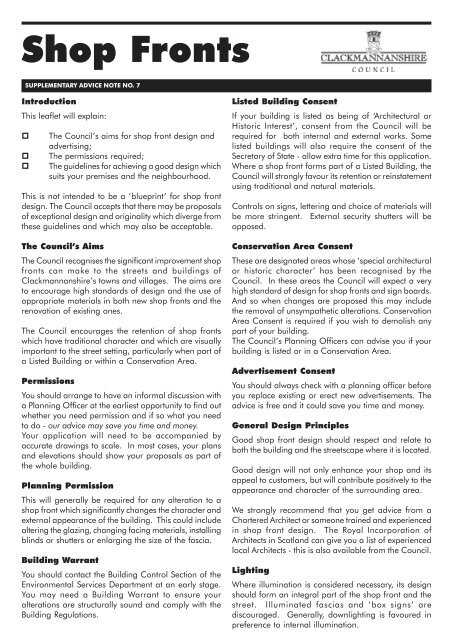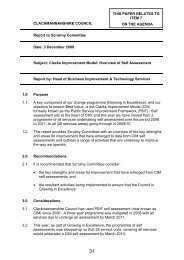Create successful ePaper yourself
Turn your PDF publications into a flip-book with our unique Google optimized e-Paper software.
<strong>Shop</strong> <strong>Fronts</strong><br />
SUPPLEMENTARY ADVICE NOTE NO. 7<br />
Introduction<br />
This leaflet will explain:<br />
The Council’s aims for shop front design and<br />
advertising;<br />
The permissions required;<br />
The guidelines for achieving a good design which<br />
suits your premises and the neighbourhood.<br />
This is not intended to be a ‘blueprint’ for shop front<br />
design. The Council accepts that there may be proposals<br />
of exceptional design and originality which diverge from<br />
these guidelines and which may also be acceptable.<br />
The Council’s Aims<br />
The Council recognises the significant improvement shop<br />
fronts can make to the streets and buildings of<br />
Clackmannanshire’s towns and villages. The aims are<br />
to encourage high standards of design and the use of<br />
appropriate materials in both new shop fronts and the<br />
renovation of existing ones.<br />
The Council encourages the retention of shop fronts<br />
which have traditional character and which are visually<br />
important to the street setting, particularly when part of<br />
a Listed Building or within a Conservation Area.<br />
Permissions<br />
You should arrange to have an informal discussion with<br />
a Planning Officer at the earliest opportunity to find out<br />
whether you need permission and if so what you need<br />
to do - our advice may save you time and money.<br />
Your application will need to be accompanied by<br />
accurate drawings to scale. In most cases, your plans<br />
and elevations should show your proposals as part of<br />
the whole building.<br />
Planning Permission<br />
This will generally be required for any alteration to a<br />
shop front which significantly changes the character and<br />
external appearance of the building. This could include<br />
altering the glazing, changing facing materials, installing<br />
blinds or shutters or enlarging the size of the fascia.<br />
Building Warrant<br />
You should contact the Building Control Section of the<br />
Environmental Services Department at an early stage.<br />
You may need a Building Warrant to ensure your<br />
alterations are structurally sound and comply with the<br />
Building Regulations.<br />
Listed Building Consent<br />
If your building is listed as being of ‘Architectural or<br />
Historic Interest’, consent from the Council will be<br />
required for both internal and external works. Some<br />
listed buildings will also require the consent of the<br />
Secretary of State - allow extra time for this application.<br />
Where a shop front forms part of a Listed Building, the<br />
Council will strongly favour its retention or reinstatement<br />
using traditional and natural materials.<br />
Controls on signs, lettering and choice of materials will<br />
be more stringent. External security shutters will be<br />
opposed.<br />
Conservation Area Consent<br />
These are designated areas whose ‘special architectural<br />
or historic character’ has been recognised by the<br />
Council. In these areas the Council will expect a very<br />
high standard of design for shop fronts and sign boards.<br />
And so when changes are proposed this may include<br />
the removal of unsympathetic alterations. Conservation<br />
Area Consent is required if you wish to demolish any<br />
part of your building.<br />
The Council’s Planning Officers can advise you if your<br />
building is listed or in a Conservation Area.<br />
Advertisement Consent<br />
You should always check with a planning officer before<br />
you replace existing or erect new advertisements. The<br />
advice is free and it could save you time and money.<br />
General Design Principles<br />
Good shop front design should respect and relate to<br />
both the building and the streetscape where it is located.<br />
Good design will not only enhance your shop and its<br />
appeal to customers, but will contribute positively to the<br />
appearance and character of the surrounding area.<br />
We strongly recommend that you get advice from a<br />
Chartered Architect or someone trained and experienced<br />
in shop front design. The Royal Incorporation of<br />
Architects in Scotland can give you a list of experienced<br />
local Architects - this is also available from the Council.<br />
Lighting<br />
Where illumination is considered necessary, its design<br />
should form an integral part of the shop front and the<br />
street. Illuminated fascias and ‘box signs’ are<br />
discouraged. Generally, downlighting is favoured in<br />
preference to internal illumination.
<strong>Shop</strong> Front Elements<br />
All buildings, old and new, provide a framework into<br />
which a shop front can be inserted. The shop front<br />
itself, whether traditional or modern, usually consists of<br />
a number of components all of which have aesthetic<br />
and functional values.<br />
Pilasters ilasters ilasters: ilasters These vertically separate individual shop units,<br />
and normally relate to the width and design of the<br />
building above. They give each unit a separate identity<br />
and may highlight the doorway. They should be retained<br />
or incorporated as appropriate.<br />
If your shop combines two or more shop units, the rhythm<br />
of the street frontage and the original buildings must be<br />
taken into account.<br />
Cornice Cornice: Cornice This visually separates the ground floor shop<br />
from the floors above and emphasises the distinction<br />
between the uses within the building. The fascia and<br />
signs should therefore be set below the cornice. Where<br />
no cornice exists, it should normally be introduced at<br />
first floor level at the top of the fascia.<br />
Stall Stall Riser Riser: Riser This is the solid base of the shop front.<br />
Functionally, it protects the display windows against street<br />
level damage, and allows ventilation or access to<br />
basement and cellars. It is always preferred to full depth<br />
glazing.<br />
Unsympathetic treatment of shopfront fascias<br />
Clerestory Clerestory: Clerestory This is occasionally provided to give extra<br />
light or ventilation and modify the proportion of tall<br />
windows. It may be decorated or sub divided. It should<br />
not be incorporated as part of the fascia.<br />
Fascia ascia ascia: ascia The street number and trade name of the shop<br />
are normally displayed on the fascia panel. The size<br />
and scale of the fascia and associated lettering can have<br />
a considerable impact on the character and appearance<br />
of buildings and the street. The following guidelines<br />
will help you:-<br />
Design the fascia as an integral part of the<br />
shop front. Keep the scale and proportion<br />
sympathetic to the building as a whole, its<br />
neighbours and the street.<br />
Where an existing fascia is excessively deep,<br />
consider replacing it in proportion to the shop<br />
front - the original fascia may be behind.<br />
Keep new fascia panels flush with the face of<br />
the surrounding framework - box fascias can<br />
look very clumsy.<br />
Choose materials which relate sympathetically<br />
with the external materials of the building as a<br />
whole - traditional materials are stone or<br />
timber. Avoid glossy materials. New shop<br />
fronts which are not in ‘sensitive’ areas may<br />
use plastics, but they should be of a matt<br />
finish.<br />
Entrance Entrance Entrance and and and Display Display Display Area Area: Area This is contained within<br />
the framework of pilasters, fascia and stallriser.<br />
Generally, an excessive amount of plate glass should<br />
be avoided and the entrance must be easily<br />
distinguishable from adjoining windows.<br />
Materials used should be compatible with the surrounds.<br />
Consider sub-dividing large windows by mullions and<br />
the door frame, to avoid an excessively horizontal<br />
emphasis to the shop front.<br />
Doors must allow easy access for wheelchairs,<br />
pushchairs and prams. Consider a recessed entrance<br />
to add interest and to provide shelter.<br />
The needs of disabled people must be considered and<br />
for advice on this you should contact the Community<br />
Access Officer for disability.<br />
Signs and Advertisements<br />
<strong>Shop</strong> front signs can have a big impact on the<br />
appearance of the shop and the street as a whole. The<br />
following guidelines will help you:<br />
Relate the size of the lettering to the area of<br />
the fascia in a style appropriate to the shop<br />
front and building.<br />
Consider using hand painted signs. They give<br />
a shop a unique character.<br />
In some instances, a fascia may not be<br />
appropriate. Consider applying lettering directly
to the building or to the display window glazing.<br />
A fascia may not be necessary<br />
Avoid signs above ground floor level. Exceptions<br />
may be made for upper floor businesses.<br />
Lettering should be small and discreet. At ground<br />
floor level an appropriate plate or sign can be<br />
sited.<br />
A fascia may not be necessary<br />
The excessive use of ‘house styles’ by chain<br />
stores, building societies, and many<br />
others has caused a great deal of<br />
damage to the character of many<br />
towns. If you wish to use a corporate<br />
sign or logo, consider adapting it<br />
to suit the building and the<br />
individual conditions of the site.<br />
Projecting rojecting Signs Signs: Signs If you are<br />
considering a projecting sign, come<br />
and discuss this with a Planning<br />
Officer at an early stage.<br />
Where appropriate, the Council favours high quality<br />
small traditional signs hung from a bracket, with external<br />
lighting if required. There will normally be a limit of<br />
one projecting sign for each shop.<br />
Advertising dvertising on on shop shop fronts fronts: fronts Excessive advertising is out<br />
of place on shop fronts and will be discouraged by the<br />
Council. Sales posters attached to the inside of display<br />
windows are also discouraged - and require consent if<br />
they cover more than 10% of the display area.<br />
Canopies<br />
Canopies and sun shades are a well established feature<br />
of some shopping streets, and as well as serving a<br />
practical need, can enliven the streetscene. The<br />
following guidelines apply:-<br />
retractable canopies should be fitted below first<br />
floor level and generally below fascia level.<br />
Because of their dominating shape,‘Balloon’ type<br />
canopies will be discouraged.<br />
Canopies should have a non-reflective surface.<br />
Lettering on canopies will be discouraged, but<br />
where it is considered justifiable the lettering<br />
should be small and the wording minimal.<br />
Canopies on listed buildings will be discouraged.<br />
canopy to high<br />
Traditional Canopy<br />
preferred postion<br />
Non-traditional Canopy<br />
canopy to low preferred postion<br />
Security<br />
It is important to consider all aspects of security. You<br />
may obtain advice on ‘Secured by Design’ from the<br />
Central Scotland Police. Traditional shop fronts with<br />
smaller paned glass, transoms, mullions and stallrisers<br />
can prove more difficult to break into. Security can also<br />
be achieved by opening up the window areas to allow a<br />
better view from the street into the shop.<br />
Consider fitting an alarm as an integral part of the shop<br />
front design. (On listed buildings consent will be<br />
required) Avoid siting it in a prominent position and<br />
consider colouring it to match the building. Where<br />
possible, site alarms inside windows or fanlights.<br />
Modern <strong>Shop</strong>s<br />
<strong>Shop</strong>s forming part of modern buildings can offer<br />
different opportunities. Clear, modern design and<br />
materials can help corner shops to become focal points<br />
in their area. Advertising ‘clutter’ should be avoided,<br />
and security measures should avoid creating bleak<br />
frontages covered with shutters and grilles.<br />
Modern blocks or parades of shops need not mimic<br />
traditional designs and materials. However, they can<br />
benefit from using the broad design guidance given in<br />
this leaflet.<br />
Shutters<br />
Consider using laminated glass, and if necessary a lattice<br />
grille behind the glazing. Fit a gate if the shop entrance<br />
is recessed.<br />
Projecting roller shutters and boxes which obscure the<br />
window display detract from the visual impact of the<br />
building and will be discouraged. Where security is a
major problem, and an external shutter is the only<br />
solution, open mesh shutters will be preferred. These<br />
shutters should cover only the glazed areas and not the<br />
whole of the shop front.<br />
Useful Useful Contacts<br />
Contacts<br />
Planning Planning P PPermission<br />
P ermission and and Advertising Advertising Consent<br />
Consent<br />
Development Services,<br />
Kilncraigs, Alloa,<br />
FK10 1EB Tel: 01259 450000<br />
Building Building Regulations<br />
Regulations<br />
Building Standards,<br />
Environmental Services, Kilncraigs, Alloa,<br />
FK10 1EB Tel: 01259 450000<br />
Architectural Architectural Advice<br />
Advice<br />
Royal Incorporation of Architects in Scotland, 15<br />
Rutland Square, Edinburgh Tel: 0131 229 7205<br />
Crime Crime Crime P PPrevention<br />
P revention<br />
Community Safety Department, Police Office, West<br />
Bridge Street, Falkirk, FK1 5AP<br />
Disability<br />
Disability<br />
Community Access Officer, c/o Central <strong>Shop</strong> Mobility<br />
Ltd, Car Park Level 4, Callendar Square <strong>Shop</strong>ping<br />
Centre, High Street, Falkirk,<br />
FK1 1UJ Tel: 01324 630500<br />
Produced by:<br />
Development & Environmental Services<br />
Clackmannanshire Council<br />
Kilncraigs, Greenside Street,<br />
Alloa, FK10 1EB<br />
Telephone: (01259) 450000<br />
Fax: (01259) 727450<br />
development_services@clacks.gov.uk<br />
www.clacksweb.org.uk
















